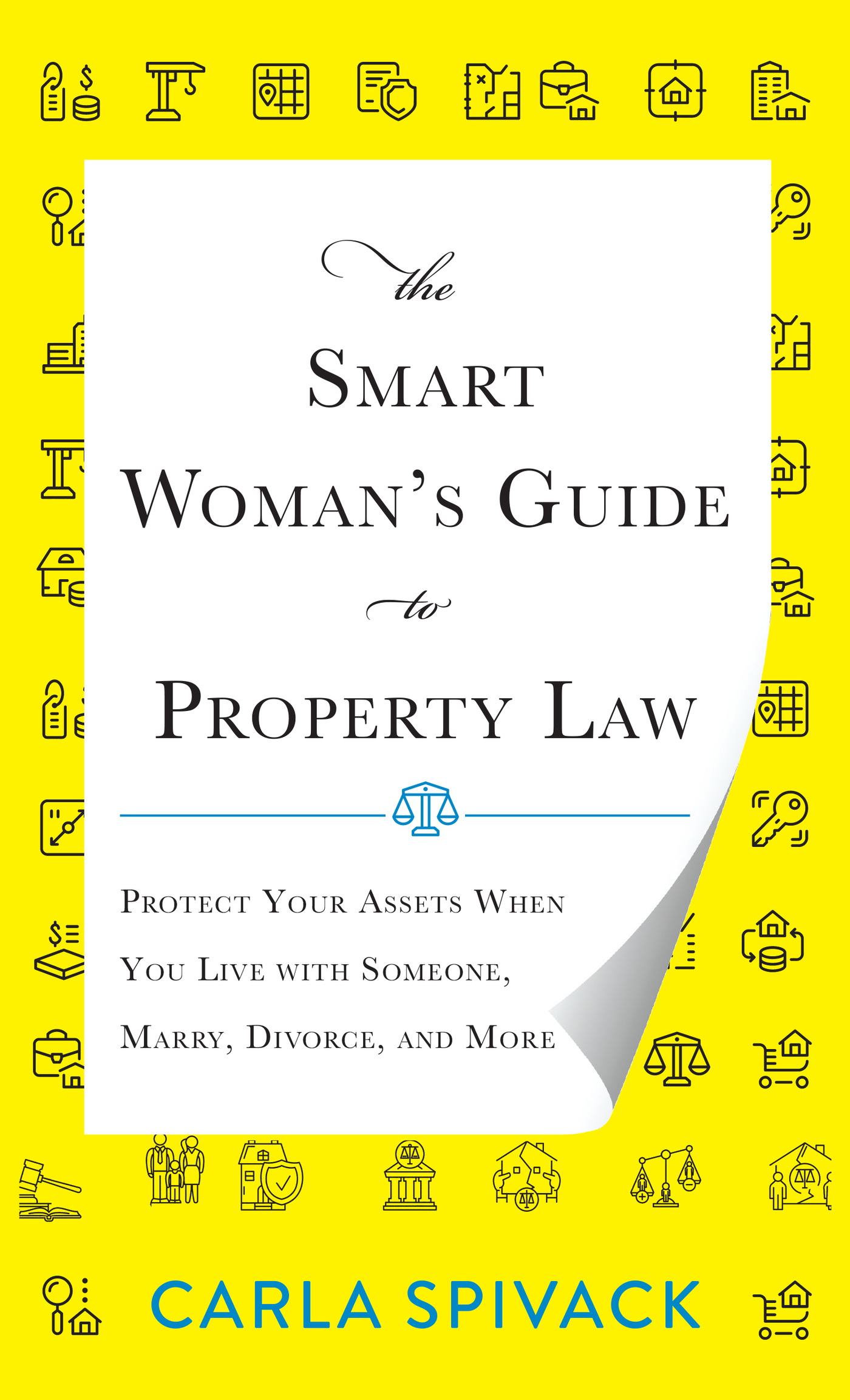The Smart Womans Guide to Property Law
The Smart Womans Guide to Property Law
Protect Your Assets When
You Live with Someone,
Marry, Divorce, and More
Carla Spivack
ROWMAN & LITTLEFIELD
Lanham Boulder New York London
Published by Rowman & Littlefield
An imprint of The Rowman & Littlefield Publishing Group, Inc.
4501 Forbes Boulevard, Suite 200, Lanham, Maryland 20706
www.rowman.com
6 Tinworth Street, London SE11 5AL
Copyright 2020 by The Rowman & Littlefield Publishing Group, Inc.
All rights reserved. No part of this book may be reproduced in any form or by any electronic or mechanical means, including information storage and retrieval systems, without written permission from the publisher, except by a reviewer who may quote passages in a review.
British Library Cataloguing in Publication Information Available
Library of Congress Cataloging-in-Publication Data
Name: Spivack, Carla, 1961, author.
Title: The smart womans guide to property law : protect your assets when you live with someone, marry, divorce, and more / Carla Spivack.
Description: Lanham : Rowman & Littlefield Publishing Group, 2020. | Includes bibliographical references and index. | Summary: The Smart Womans Guide to Property Law shows how current property laws cheat women at various stages of life: marriage, caretaking, childrearing, outliving your spouse, inheritance, and more. Carla Spivack illuminates these pitfalls and shows women how to avoid them, protect their wealth, and build for the futureProvided by publisher.
Identifiers: LCCN 2019051341 (print) | LCCN 2019051342 (ebook) | ISBN 9781538134917 (cloth) | ISBN 9781538134924 (epub)
Subjects: LCSH: Marital propertyUnited States. | WomenUnited StatesHandbooks, manuals, etc.
Classification: LCC KF524 .S65 2020 (print) | LCC KF524 (ebook) | DDC 346.7304dc23
LC record available at https://lccn.loc.gov/2019051341
LC ebook record available at https://lccn.loc.gov/2019051342
 TM The paper used in this publication meets the minimum requirements of American National Standard for Information Sciences Permanence of Paper for Printed Library Materials, ANSI/NISO Z39.48-1992.
TM The paper used in this publication meets the minimum requirements of American National Standard for Information Sciences Permanence of Paper for Printed Library Materials, ANSI/NISO Z39.48-1992.
For Rachel Spivack, JD,
University of Pennsylvania Law School, 2021
Acknowledgments
Its true what authors say. There are so many people whose support, feedback, and patience were essential to this book seeing the light of day. My amazing agent, Barbara Braun, believed in this project and stuck with it through thick and thin. My wonderful editor, Genoveva Llosa, taught me to write in English instead of legaleseand any failures in that regard are mine, not hers! Im also grateful beyond words for the ongoing support of my colleagues at Oklahoma City University School of Law, in particular Dean Valerie K. Couch, who granted me the initial financial support to start writing, Paula J. Dalley, Michael T. Gibson, and Shannon Roessler, cheerleaders throughout. My assistant, Vickey Cannady, performed miracles of formatting and editing without batting an eye (as usual), and my research assistant, Emma C. Kincaide, diligently and enthusiastically accomplished the tedious task of compiling the index. Ophthalmologists B. Thomas Hutchinson, Claudia U. Richter, and Steven R. Sarkisian have kept my eyes working lo these many years, which really helped.
So many friends and colleagues gave me much needed encouragement and feedback throughout this process: R. B. Bernstein, Amy Boesky, Jessica L. Brown, Naomi R. Cahn, Allison R. Carmody, Elizabeth R. Carter, Loy Corder, Mary Thomas Crane, Susan Carns Curtis, Harold Forsythe, Lawrence Friedman, Deborah Gordon, Victoria J. Hanneman, Eric B. Hermanson, Debra Jackson, Ray D. Madoff, Seth Markley, Elizabeth Meier, Mimi and Gerry Raphel, Kent D. Schenkel, Harry M. Schuman, Rise Simon, Allison Anna Tait, and Danaya Wright.
Finally, my thanks to Misha and Luba, for encouraging me and putting up with me, through this and everything else.
Introduction
Two years after Robert and Amy were married, Robert completed his medical degree, and they relocated so he could complete his residency. Amy had an MBA and worked as a program analyst, but shortly after they moved she was diagnosed with fibromyalgia and chronic fatigue syndrome, leading Amy and Robert to agree that she would leave work and stay home full time. They had two children. After nineteen years of marriage, Amy filed for divorce. The court awarded her alimony of $35,000 per year for five years and $20,000 after that for her lifetime, including child support, as well as the title to their home with responsibility for the mortgage, taxes, and repayment of home equity loans. As for Roberts degree, the court awarded Amy 35 percent of the marital portion of Roberts future earnings, which amounted to annual payments to her of $21,288 for a total of $214,400. So Amy, now forty-six, in poor health and absent from the job market for more than seventeen years, must now forego a shared income of about $200,000 per year and support herself on about $40,000.
Does this seem unfair to you? It should. Amys story is all too common among women seeking divorce today. Thats because women are statistically more likely to sacrifice their own professional development to advance their husbands careers. When a marriage ends in divorce, women often dont get a return on their investmentand are left with less ability to create wealth on their own. Why? Our legal systemspecifically property lawshas much to do with it. In the case of divorces like Amys, courts are supposed to divide family property fairly, taking into account even a stay-at-home spouses unpaid contribution. But courts often ignore the largest asset of the financially independent spouse (statistically likely to be the man in a heterosexual relationship): his career and professional degree. Most courts refuse to treat a spouses increasing earning power as the result of an advanced degree as property to be shared with the other spouse at divorce.
And just as women are likely to have their ability to create wealth or hold on to it be limited by the legal system during a divorce, property laws disadvantage women at key stages of their lives: when cohabiting with a man instead of getting married, signing a prenuptial agreement, surviving an abusive relationship, caring for elderly parents, outliving their husbands, and inheriting property.
How is this possible? Ive been teaching the history of women and property law for many years, and I wondered the same thing. The story of women and property law is supposed to be one of progress. The law once discriminated overtly against womennot letting them inherit, for examplebut all that has changed; now the law treats men and women the same when it comes to acquiring, managing, and transferring property, not to mention pursuing high-paying professions. That should have solved the problem, right? With legal impediments removed, womens and mens assets should have equalized over the years.
But if were still at thirty-two cents for every dollar men own in wealth, something went wrong. This book explains what, as well as what you can do about it. In a nutshell, the problem is that, while the law has changed, too many other things about the situation of women haventthe pressure to marry, the uneven distribution of child and eldercare, the difficulty of advancing in a high-paying career while raising kids, womens greater exposure to domestic violence, and the mere fact that women live longer than menthese things have not changed. So by treating men and women the same, the law actually perpetuates inequality. This book explains howand how you can protect yourself.
Next page
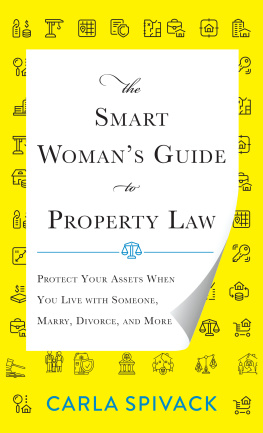
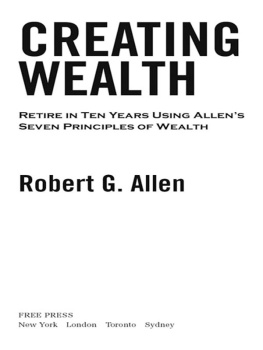

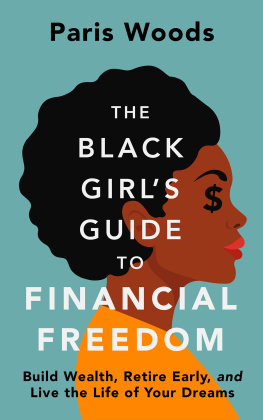


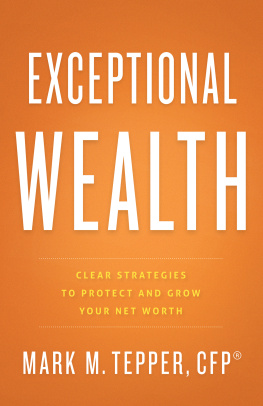

 TM The paper used in this publication meets the minimum requirements of American National Standard for Information Sciences Permanence of Paper for Printed Library Materials, ANSI/NISO Z39.48-1992.
TM The paper used in this publication meets the minimum requirements of American National Standard for Information Sciences Permanence of Paper for Printed Library Materials, ANSI/NISO Z39.48-1992.